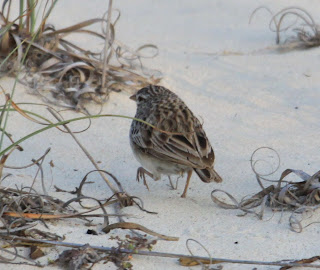Much more to come, hopefully soon, right now flight awaiting, battery running low and damn lucky to get Internet access anyway. Take care, hope to be back tomorrow from Fort Dauphin. So much more to come!
Tuesday 26th October 2010
Following on from the last post, we spent a excellent 2 days in and around the Isalo National Park. After an early (05-30) walk around the hotel grounds, where we easilr found distant Benson's Rock Thrush and Naquama Dove' we breakfasted before driving the short distance to the Canyon de Singe and Rat Canyon where the local tribe bury their dead, the rodents taking full advantage. We looked for, but didn't find, Verreaux;s Sifaka but did stumble upon a small troup of the even more scarce Red-fronted Brown Lemur and a number of Madagascar Black Swift. Some took advantage of the Piscine Naturelle to take a cooling swim while I headed off for my daily meditation and singing session, must keep those chords streached. Any kind of wildlife watching was difficult in the seering heat, so by mid-day we returned to the hotel for lunch and a short seista,after which a few of us climbed a nearby mountain to best enjoy a dramatic sunset. The day ended on a bit of a worrying note as on our decent we lost one of our party, and took a full 90 minutes to find her. It is pleasing to report that all's well that ends well.
 The Canyons
The Canyons Madagascar Cuckoo Roller
Madagascar Cuckoo Roller Madagascar Black Swift
Madagascar Black Swift Madagascar Buzzard
Madagascar Buzzard Yellow-billed Kite in flight
Yellow-billed Kite in flight
From back left:- Caroline Tero, Michael Lenz, Janette Lenz, Kathy Walter, John Goldie,Jules Bennett, Steve Bennett, William Plumb, Steve Woodham, Jonas Christiansen
Marie Djumic, Yours Truely, Cathy Harlow (Tour Leader)
 Mascarine Martin
Mascarine Martin O'Shaughnessy's Chameleon
O'Shaughnessy's Chameleon Orchid
Orchid Ornate Plated Lizard
Ornate Plated Lizard Red-fronted Brown Lemur
Red-fronted Brown LemurWednesday 27th October 2010
An even earlier start this morning, we left Isalo at 04-00 to make the most of the birds at the dry transitional (between rain and spiny forests) forest at Zombitze just an hour down the road. On the way we passed through the Sapphire mining town of Hakaka, which until just a short decade ago was a village of 200 people, now swollen to 20,000 and rife with crime on account of the precious stones. In transit we found the introduced Helmeted Guineafolw, in numbers, feeding at the side of the road, plus the far less obliging Madagascar Buttonquail conceled by the forest edge. There followed a very easy walk along a spongy but dry forest track, where we soon encountered Grey-headed Lovebird, Crested Coua and Lesser Vasa Parrot. There were 2 very important target species in this unique parcel of woodland and we were not to leave disappointed. Firstly, our 'local' guide found a single Hubbard's Sportative Lemur roosting in a tree hole, followed shortly after by Appet's Greenbul, a serious 'sculker'. In all we saw 4 of these rare birds which only inhabit this area (in the world) and I was even lucky enough to capture the images below. In addition Sakalava Weaver, Coquerel's Coua and Rufous Vanga were added to the list, and as we arrived back at the main road, after a 3 hour walk, a troop of Verreaux's Sifaka were waiting for us. Not totally obliging, some shots were obtained but the sun was now taking its toll. It was unanimously agreed that once reaching our hotel a period of poolside relaxation would ensue, as all ideas of visiting the local Botanical Gardens were dispelled. On the downside, I was one of the few to miss seeing the elusive Running Coua, while Great Coua was only heard. We spent the night at Tulear.

Weaver's Nest
 Madagascar Cisticola
Madagascar Cisticola






































